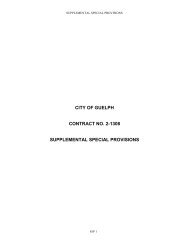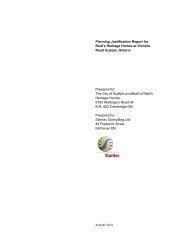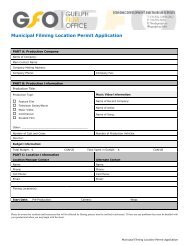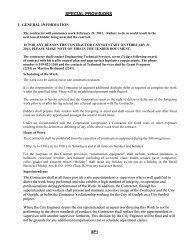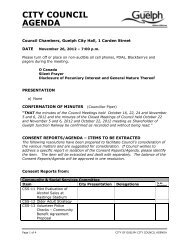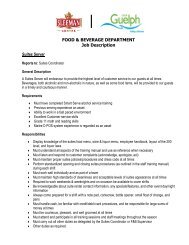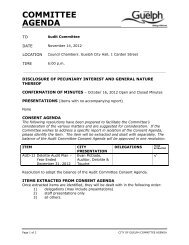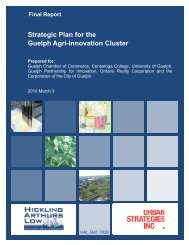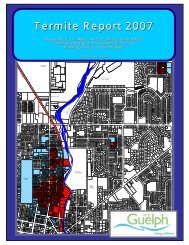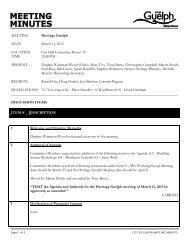- Page 1: City of Guelph2008 Annual ReportClo
- Page 4 and 5: City of Guelph2008 Annual ReportClo
- Page 6 and 7: City of Guelph2008 Annual ReportClo
- Page 8: City of Guelph2008 Annual ReportClo
- Page 11 and 12: City of Guelph2008 Annual ReportClo
- Page 13 and 14: City of Guelph2008 Annual ReportClo
- Page 15 and 16: City of Guelph2008 Annual ReportClo
- Page 17 and 18: City of Guelph2008 Annual ReportClo
- Page 19 and 20: City of Guelph2008 Annual ReportClo
- Page 21 and 22: City of Guelph2008 Annual ReportClo
- Page 23 and 24: City of Guelph2008 Annual ReportClo
- Page 25: City of Guelph2008 Annual ReportClo
- Page 29 and 30: City of Guelph2008 Annual ReportClo
- Page 31 and 32: City of Guelph2008 Annual ReportClo
- Page 33 and 34: City of Guelph2008 Annual ReportClo
- Page 35 and 36: City of Guelph2008 Annual ReportClo
- Page 37 and 38: City of Guelph2008 Annual ReportClo
- Page 39 and 40: City of Guelph2008 Annual ReportClo
- Page 41 and 42: City of Guelph2008 Annual ReportClo
- Page 43 and 44: City of Guelph2008 Annual ReportClo
- Page 45 and 46: City of Guelph2008 Annual ReportClo
- Page 47 and 48: City of Guelph2008 Annual ReportClo
- Page 49 and 50: City of Guelph2008 Annual ReportClo
- Page 51 and 52: City of Guelph2008 Annual ReportClo
- Page 53 and 54: City of Guelph2008 Annual ReportClo
- Page 55 and 56: City of Guelph2008 Annual ReportClo
- Page 57 and 58: City of Guelph2008 Annual ReportClo
- Page 59 and 60: City of Guelph2008 Annual ReportClo
- Page 61 and 62: City of Guelph2008 Annual ReportClo
- Page 63 and 64: Table 10. Summary of Surface Water
- Page 65 and 66: City of Guelph2008 Annual ReportClo
- Page 67 and 68: City of Guelph2008 Annual ReportClo
- Page 69 and 70: City of Guelph2008 Annual ReportClo
- Page 71 and 72: City of Guelph2008 Annual ReportClo
- Page 73 and 74: City of Guelph2008 Annual ReportClo
- Page 75 and 76: City of Guelph2008 Annual ReportClo
- Page 77 and 78:
City of Guelph2008 Annual ReportClo
- Page 79 and 80:
City of Guelph2008 Annual ReportClo
- Page 81 and 82:
City of Guelph2008 Annual ReportClo
- Page 83 and 84:
City of Guelph2008 Annual ReportClo
- Page 85 and 86:
City of Guelph2008 Annual ReportClo
- Page 87 and 88:
City of Guelph2008 Annual ReportClo
- Page 90:
CollectionSystemWestPumpingStationL
- Page 93 and 94:
345Invert MH 2W MH 4W MH 5W WEST TA
- Page 95 and 96:
343.0342.552-ITarget ElevationEleva
- Page 97 and 98:
345.5C10-II D4-I MH 4SHighest Top o
- Page 99:
3.0C3-I - MH 6W C2-II - M H 4W C1-I
- Page 105 and 106:
10919-I 20-I 4-I 4-IR 53-I 54-I 90-
- Page 108 and 109:
Jul-10Jan-10Jul-09Jan-09Jul-08Jan-0
- Page 110 and 111:
Appendix AGroundwater Monitoring Da
- Page 112 and 113:
A1: Monitor Construction DetailsBor
- Page 114 and 115:
A1: Monitor Construction DetailsBor
- Page 116 and 117:
A1: Monitor Construction DetailsBor
- Page 118 and 119:
A2: Groundwater Elevations - - East
- Page 120 and 121:
A2: Groundwater Elevations - - East
- Page 122 and 123:
A2: Groundwater Elevations - - East
- Page 124 and 125:
A2: Groundwater Elevations - - East
- Page 126 and 127:
A2: Groundwater Elevations - - East
- Page 128 and 129:
(appendix ti pgs.doc)A3. Collection
- Page 130 and 131:
(appendix ti pgs.doc)A4. Detailed B
- Page 132 and 133:
A4 : Selected Bedrock and Lower Til
- Page 134 and 135:
A4 : Selected Bedrock and Lower Til
- Page 136 and 137:
A4 : Selected Bedrock and Lower Til
- Page 138 and 139:
A5 : Routine Leachate Groundwater E
- Page 140 and 141:
A5 : Routine Leachate Groundwater E
- Page 142 and 143:
A5 : Routine Leachate Groundwater E
- Page 144 and 145:
A5 : Routine Leachate Groundwater E
- Page 146 and 147:
GRAPHICS, SYMBOLS AND ABBREVIATIONS
- Page 148 and 149:
BOREHOLE LOGFurther Drilling at Eas
- Page 150 and 151:
BOREHOLE LOGFurther Drilling at Eas
- Page 152 and 153:
BOREHOLE LOGPROJECT:70-131BOREHOLE:
- Page 154 and 155:
MOE Water Well Records ReportGLL 80
- Page 156 and 157:
36019-I 20-I 4-IR 53-I 54-I North O
- Page 158 and 159:
36015-I 15-II 15-III 15-IV 15-V3553
- Page 160 and 161:
35553-I 53-II 53-IIR C2-I C2-II3503
- Page 162 and 163:
B1. Flow Meter Readings and Summary
- Page 164 and 165:
TABLE B1 - SUMMARY OF LEACHATE DISC
- Page 166 and 167:
B2. South and West Pump Stations, H
- Page 168 and 169:
B3. Monthly Leachate Quantities and
- Page 170 and 171:
B4. Manhole Leachate Elevations, So
- Page 172 and 173:
B5. Manhole Leachate Elevations, We
- Page 174 and 175:
Appendix CGroundwater, Surface Wate
- Page 176 and 177:
C1: Routine Leachate Quality - Gene
- Page 178 and 179:
C1: Routine Leachate Quality - Gene
- Page 180 and 181:
C1: Routine Leachate Quality - Gene
- Page 182 and 183:
C1: Routine Leachate Quality - Gene
- Page 184 and 185:
C1: Routine Leachate Quality - Gene
- Page 186 and 187:
C1: Routine Leachate Quality - Gene
- Page 188 and 189:
C1: Routine Leachate Quality - Trac
- Page 190 and 191:
C1: Routine Leachate Quality - Trac
- Page 192 and 193:
C1: Routine Leachate Quality - Trac
- Page 194 and 195:
C1: Routine Leachate Quality - Trac
- Page 196 and 197:
C1: Routine Leachate Quality - Trac
- Page 198 and 199:
(appendix ti pgs.doc)C2. Groundwate
- Page 200 and 201:
C2: Routine Groundwater Quality - G
- Page 202 and 203:
C2: Routine Groundwater Quality - G
- Page 204 and 205:
C2: Routine Groundwater Quality - G
- Page 206 and 207:
C2: Routine Groundwater Quality - G
- Page 208 and 209:
C2: Routine Groundwater Quality - G
- Page 210 and 211:
C2: Routine Groundwater Quality - G
- Page 212 and 213:
C2: Routine Groundwater Quality - G
- Page 214 and 215:
C2: Routine Groundwater Quality - G
- Page 216 and 217:
C2: Routine Groundwater Quality - G
- Page 218 and 219:
C2: Routine Groundwater Quality - G
- Page 220 and 221:
C2: Routine Groundwater Quality - G
- Page 222 and 223:
C2: Routine Groundwater Quality - G
- Page 224 and 225:
C2: Routine Groundwater Quality - G
- Page 226 and 227:
C2: Routine Groundwater Quality - G
- Page 228 and 229:
C2: Routine Groundwater Quality - G
- Page 230 and 231:
C2: Routine Groundwater Quality - G
- Page 232 and 233:
C2: Routine Groundwater Quality - G
- Page 234 and 235:
C2: Routine Groundwater Quality - G
- Page 236 and 237:
C2: Routine Groundwater Quality - G
- Page 238 and 239:
C2: Routine Groundwater Quality - G
- Page 240 and 241:
C2: Routine Groundwater Quality - G
- Page 242 and 243:
C2: Routine Groundwater Quality - G
- Page 246 and 247:
C2: Routine Groundwater Quality - T
- Page 248 and 249:
C2: Routine Groundwater Quality - T
- Page 250 and 251:
C2: Routine Groundwater Quality - T
- Page 252 and 253:
C2: Routine Groundwater Quality - T
- Page 254 and 255:
C2: Routine Groundwater Quality - T
- Page 256 and 257:
C2: Routine Groundwater Quality - T
- Page 258 and 259:
C2: Routine Groundwater Quality - T
- Page 260 and 261:
C2: Routine Groundwater Quality - T
- Page 262 and 263:
C2: Routine Groundwater Quality - T
- Page 264 and 265:
C2: Routine Groundwater Quality - T
- Page 266 and 267:
C2: Routine Groundwater Quality - T
- Page 268 and 269:
C2: Routine Groundwater Quality - T
- Page 270 and 271:
C2: Routine Groundwater Quality - T
- Page 272 and 273:
C2: Routine Groundwater Quality - T
- Page 274 and 275:
C2: Routine Groundwater Quality - T
- Page 276 and 277:
C2: Routine Groundwater Quality - T
- Page 278 and 279:
C2: Routine Groundwater Quality - T
- Page 280 and 281:
C2: Routine Groundwater Quality - T
- Page 282 and 283:
C2: Routine Groundwater Quality - T
- Page 284 and 285:
C2: Routine Groundwater Quality - T
- Page 286 and 287:
C2: Routine Groundwater Quality - T
- Page 288 and 289:
C3: Routine Surface Water Quality -
- Page 290 and 291:
C3: Routine Surface Water Quality -
- Page 292 and 293:
C3: Routine Surface Water Quality -
- Page 294 and 295:
C3: Routine Surface Water Quality -
- Page 296 and 297:
(appendix ti pgs.doc)C4. Surface Wa
- Page 298 and 299:
C4: Surface Water Field Measurement
- Page 300 and 301:
C4: Surface Water Field Measurement
- Page 302 and 303:
C4: Surface Water Field Measurement
- Page 304 and 305:
C4: Surface Water Field Measurement
- Page 306 and 307:
C4: Surface Water Field Measurement
- Page 308 and 309:
C4: Surface Water Field Measurement
- Page 310 and 311:
C4: Surface Water Field Measurement
- Page 312 and 313:
(appendix ti pgs.doc)C5. Leachate M
- Page 314 and 315:
Table C5: CofA MISA Priority Pollut
- Page 316 and 317:
Table C5: CofA MISA Priority Pollut
- Page 318 and 319:
C6: VOLATILE ORGANIC ANALYSIS - 200
- Page 320 and 321:
(appendix ti pgs.doc)C7. Comparison
- Page 322 and 323:
Table C7: Comparison of Downgradien
- Page 324 and 325:
Table C8: Comparison of Downgradien
- Page 326 and 327:
504510-III 13 - I V 16 - IV2-I 9-I
- Page 328 and 329:
50045026-I 28-I 30-I C2-I CHLORIDE4
- Page 330 and 331:
2000180026-I 28-I 30-I C2-I ALKALIN
- Page 332 and 333:
50045013 - I 13 - II 13-IIIBEDROCK
- Page 334 and 335:
50045053 -I 53-II 53-IIR C2-IBEDROC
- Page 336 and 337:
10.09.013 - I 13 - II 13-IIIBEDROCK
- Page 338 and 339:
10.09.053 -I 53 -II 53-IIR C2-IBEDR
- Page 340 and 341:
10.09.013 - I 13 - II 13-IIIBEDROCK
- Page 342 and 343:
10.09.053 -I 53 -II 53-IIR C2-IBEDR
- Page 344 and 345:
PRIVATE WATER WELL QUALITY - GENERA
- Page 346 and 347:
PRIVATE WATER WELL QUALITY - GENERA
- Page 348 and 349:
PRIVATE WATER WELL QUALITY - GENERA
- Page 350 and 351:
PRIVATE WATER WELL QUALITY - GENERA
- Page 352 and 353:
PRIVATE WATER WELL QUALITY - GENERA
- Page 354 and 355:
PRIVATE WATER WELL QUALITY - GENERA
- Page 356 and 357:
PRIVATE WATER WELL QUALITY - GENERA
- Page 358 and 359:
PRIVATE WATER WELL QUALITY - TRACE
- Page 360 and 361:
PRIVATE WATER WELL QUALITY - TRACE
- Page 362 and 363:
PRIVATE WATER WELL QUALITY - TRACE
- Page 364 and 365:
PRIVATE WATER WELL QUALITY - TRACE
- Page 366 and 367:
PRIVATE WATER WELL QUALITY - TRACE
- Page 368 and 369:
PRIVATE WATER WELL QUALITY - TRACE
- Page 370 and 371:
Appendix ECombustible Gas Monitorin
- Page 372 and 373:
TABLE E1 - GAS CONCENTRATIONS READI
- Page 374 and 375:
TABLE E2 - GAS CONCENTRATIONS IN C
- Page 376 and 377:
TABLE E3 - GAS CONCENTRATIONS IN C
- Page 378 and 379:
TABLE E4 - GAS CONCENTRATION READIN
- Page 380 and 381:
TABLE E5 - GAS CONCENTRATION AND PR
- Page 382 and 383:
TABLE E6 - METHANE GAS CONCENTRATIO
- Page 384 and 385:
TABLE E6 - METHANE GAS CONCENTRATIO
- Page 386 and 387:
TABLE E7 - METHANE GAS READINGS - W
- Page 388:
Appendix FAir Quality Monitoring Re
- Page 398 and 399:
2.94.14.91.00.016%14%12%10%8%6%4%2%
- Page 400 and 401:
10.00.00.00.00.040%35%30%25%20%15%1
- Page 402 and 403:
City of GuelphAppendix G - Water Bu
- Page 404 and 405:
250200MM PER MONTH150100500-50Jan F



